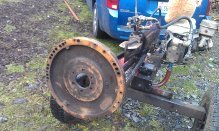Scooby074
Super Member
On the wedge.
I was going to go with a euro style vertical knife, mostly for the "slicing" ability with a 4 way behind it. This 4 way would just look like a T and be hydraulic. Using the hydraulics you could pull the cross of the T right down to the top of the I beam allowing for a 2 way split.
However, when I built mine, I crossed the Euro knife with the North American wide, wing wedge. So the first 1.5-2" of my wedge is knife and the last bit is narrow wedge. Its only 2" wide at its widest part. My hydraulic 4 way rides over the main wedge. I can raise the cross blades high enough to allow 6" - 8" wood to go right under and get a 2 way split. If I have something particularly gnarly and large diameter, I can simply pull the pin and take the 4 way right off to get maximum splitting force. That hardly happens. Maybe once per day of splitting if that.
One other thing on the wedge is I made a stepped wedge design. 2-3" above the I beam I stepped the main wedge back a couple inches. This makes most of the splitting force concentrated right at the I beam (the strongest point). Once the wood is cracked down low, by the time it hits the remainder of the main wedge, the force required is extremely reduced. This saves twisting both the I beam and bending the main wedge in the direction of push.
I was going to go with a euro style vertical knife, mostly for the "slicing" ability with a 4 way behind it. This 4 way would just look like a T and be hydraulic. Using the hydraulics you could pull the cross of the T right down to the top of the I beam allowing for a 2 way split.
However, when I built mine, I crossed the Euro knife with the North American wide, wing wedge. So the first 1.5-2" of my wedge is knife and the last bit is narrow wedge. Its only 2" wide at its widest part. My hydraulic 4 way rides over the main wedge. I can raise the cross blades high enough to allow 6" - 8" wood to go right under and get a 2 way split. If I have something particularly gnarly and large diameter, I can simply pull the pin and take the 4 way right off to get maximum splitting force. That hardly happens. Maybe once per day of splitting if that.
One other thing on the wedge is I made a stepped wedge design. 2-3" above the I beam I stepped the main wedge back a couple inches. This makes most of the splitting force concentrated right at the I beam (the strongest point). Once the wood is cracked down low, by the time it hits the remainder of the main wedge, the force required is extremely reduced. This saves twisting both the I beam and bending the main wedge in the direction of push.

